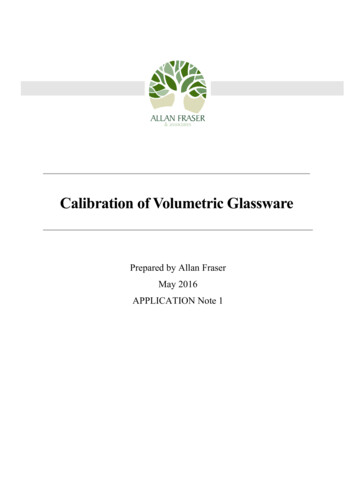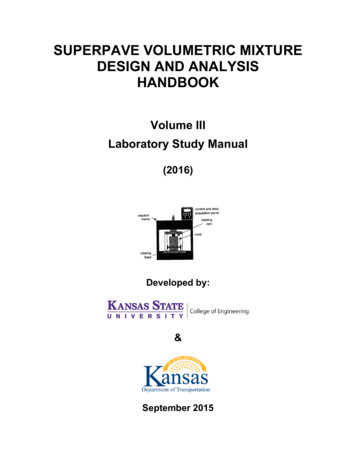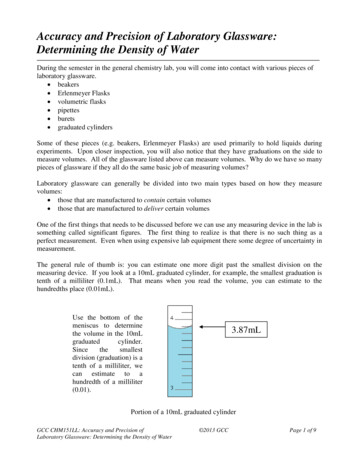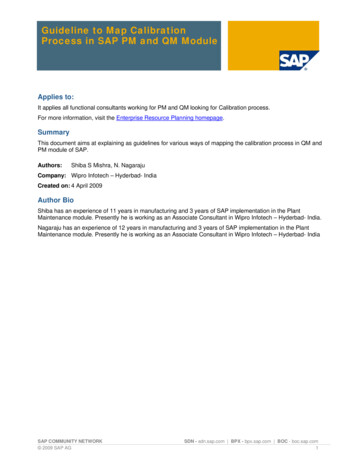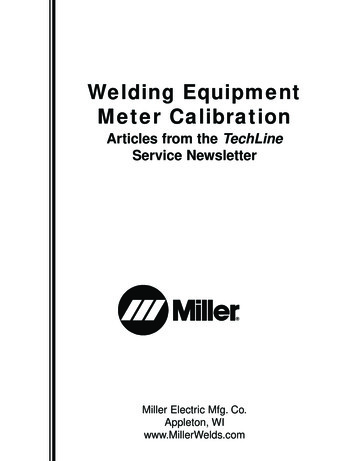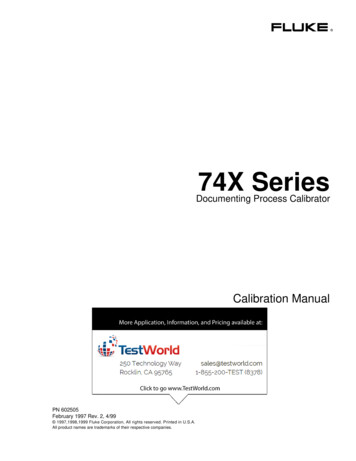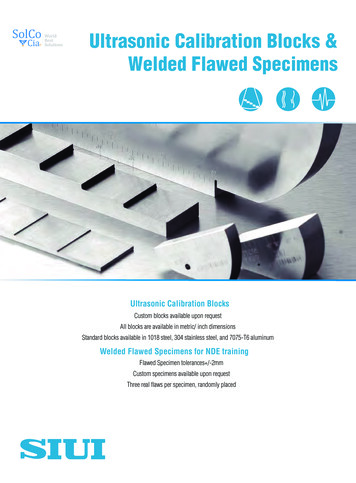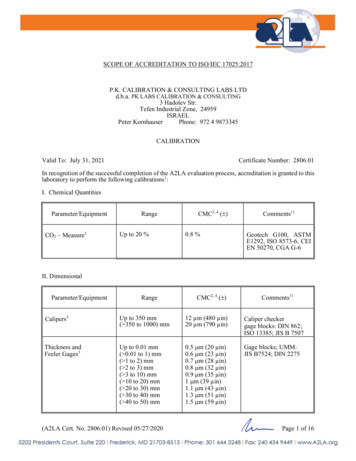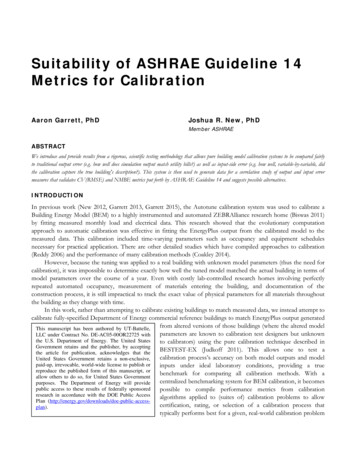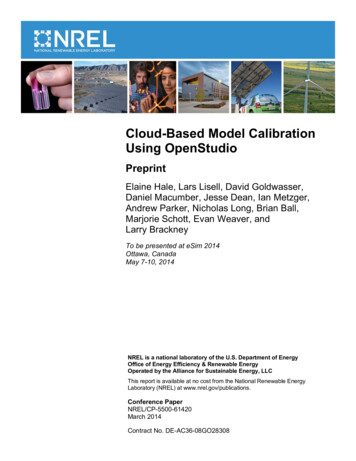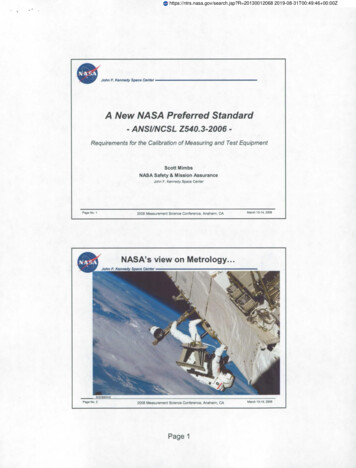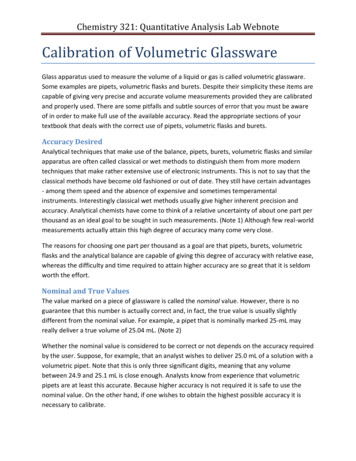
Transcription
Chemistry 321: Quantitative Analysis Lab WebnoteCalibration of Volumetric GlasswareGlass apparatus used to measure the volume of a liquid or gas is called volumetric glassware.Some examples are pipets, volumetric flasks and burets. Despite their simplicity these items arecapable of giving very precise and accurate volume measurements provided they are calibratedand properly used. There are some pitfalls and subtle sources of error that you must be awareof in order to make full use of the available accuracy. Read the appropriate sections of yourtextbook that deals with the correct use of pipets, volumetric flasks and burets.Accuracy DesiredAnalytical techniques that make use of the balance, pipets, burets, volumetric flasks and similarapparatus are often called classical or wet methods to distinguish them from more moderntechniques that make rather extensive use of electronic instruments. This is not to say that theclassical methods have become old fashioned or out of date. They still have certain advantages- among them speed and the absence of expensive and sometimes temperamentalinstruments. Interestingly classical wet methods usually give higher inherent precision andaccuracy. Analytical chemists have come to think of a relative uncertainty of about one part perthousand as an ideal goal to be sought in such measurements. (Note 1) Although few real-worldmeasurements actually attain this high degree of accuracy many come very close.The reasons for choosing one part per thousand as a goal are that pipets, burets, volumetricflasks and the analytical balance are capable of giving this degree of accuracy with relative ease,whereas the difficulty and time required to attain higher accuracy are so great that it is seldomworth the effort.Nominal and True ValuesThe value marked on a piece of glassware is called the nominal value. However, there is noguarantee that this number is actually correct and, in fact, the true value is usually slightlydifferent from the nominal value. For example, a pipet that is nominally marked 25-mL mayreally deliver a true volume of 25.04 mL. (Note 2)Whether the nominal value is considered to be correct or not depends on the accuracy requiredby the user. Suppose, for example, that an analyst wishes to deliver 25.0 mL of a solution with avolumetric pipet. Note that this is only three significant digits, meaning that any volumebetween 24.9 and 25.1 mL is close enough. Analysts know from experience that volumetricpipets are at least this accurate. Because higher accuracy is not required it is safe to use thenominal value. On the other hand, if one wishes to obtain the highest possible accuracy it isnecessary to calibrate.
Chemistry 321: Quantitative Analysis Lab WebnoteTo Contain vs. To DeliverVolumetric flasks (Vol. Flask) are designed to contain the indicated volume of liquid. The buretsand pipets (Vol. pipet) used in this laboratory are designed to deliver the stated volume ofwater or dilute aqueous solution. To indicate this difference, volumetric glassware is usuallymarked TD meaning to deliver or TC meaning to contain. Certain types of pipets, especiallymicropipets, are designed to contain a certain volume of liquid and these are marked TC. (Notethat for apparatus that is calibrated "to deliver", there may be a substantial error in volume ifthe solvent is something other than water.)Blow-outAfter using a pipet to make a delivery there is always a small amount of liquid remaining in thetip. Certain types of pipets, especially serological pipets, are designed for the operator to blowout this last bit of liquid. This is not the case for the volumetric pipets used in this laboratory.The proper technique is to allow 20 seconds for drainage, touch the tip of the pipet to theinside wall of the container or the surface of the liquid, and leave the remaining liquidundelivered. By convention, a pipet that is calibrated for blowout is marked with a white ringaround the top end.Basis for the CalibrationThe key measuring device in the laboratory is the analytical balance. The accuracy of thecounterweights inside the balance is much better than one part per thousand and the balancesare serviced and calibrated at regular intervals to ensure their accuracy.The volume of a pipet is therefore determined by weighing the water delivered into a clean drycontainer. From the weight and the density of water one can calculate the true volumedelivered. (Note 3) Similarly, in calibrating the volumetric flask, it is first weighed empty, cleanand dry. It is then filled to the mark with water and again weighed. As before, the volume iscalculated from the weight of water and its density.In the most accurate work two corrections are required. One is to correct for the differencebetween an object weighed in air and the same object weighed in vacuum. According toArchimedes’ principle an object is buoyed up by a force equal to the weight of air it displaces.Second, is the fact that glass expands with increasing temperature, so the volume of acontainer also increases. By convention, volumetric glassware is always calibrated at 20 C.Since the temperature at which you do the calibration may be somewhat different there is asmall correction for the cubic coefficient of expansion of glass. Fortunately the correction isvery small within a few degrees of 20 C and can be neglected in ordinary work. The data inTable 1-1 incorporate these corrections into the density. In order to find the true volume simplymultiply the weight of water by the relevant factor from this table. Obtain a beaker with some
Chemistry 321: Quantitative Analysis Lab WebnoteDI water, place the thermometer in the beaker; and take the temperature reading after theother measurements.Procedure for Calibration of a Volumetric FlaskThe flask must be completely dry. (Note 4) Using the top loading balance, weigh the dry emptyflask with its stopper and measure the mass, recording all the decimal places. Fill the flaskexactly to the mark with distilled water that has been allowed to reach room temperature. Anydrops of water clinging to the inside of the neck of the flask must be removed with a rolled-uppiece of paper towel, so try to avoid this. Weigh the flask, stopper, and water. Calculate thetrue volume of the flask using the conversion data in Table 1-1. Repeat the determination(empty the flask and refill) until you are confident that you have the correct volume with anuncertainty of less than one part per thousand.Volumetric flasks must NEVER be heated, either with an open flame or on a hot plate. The hightemperature causes irreversible changes in the shape of the glass and the flask must berecalibrated. Later in the term, DI water is heated up and for the same reason; it needs to becooled down to room temperature before use in order to obtain the calibrated volume.Procedure for Calibration of a PipetFigure 1 shows the 3-valve squeeze bulb that we willuse in this class; with a little practice, they make iteasy to transfer precise amounts of liquids. The threevalves allow you to independently A) squeeze the bulbto set up the vacuum, S) draw up your liquid, and E)vent the pipet to release the liquid.The bottom of the bulb (below the "T") is placed overthe top (blunt) end of the pipet. Valve (A) is pressedgently and the bulb is simultaneously squeezed toempty it of air. The tip of the pipet is then placedbelow the surface of the liquid. (Make sure you haveFigure 1 three way safety bulbenough liquid in your beaker and NEVER pipet directlyfrom a reagent bottle!) The suction valve (S) is gentlysqueezed to draw liquid into the pipet until the liquid level is at or just above the desiredvolume (the line on the pipet). DO NOT REMOVE the bulb from the pipet. DO NOT INVERT thepipet. DO NOT ALLOW LIQUID TO ENTER THE BULB. If the bulb fills with air before the level ofliquid is high enough, simply squeeze the air valve (A) and the bulb again to replenish thesuction and resume drawing up the liquid using the suction valve (S). If the liquid was drawnabove the desired level, use the empty valve (E) to release liquid back into the beaker until thebottom of the meniscus is on the line. Finally, to transfer the liquid, place the tip of the pipet
Chemistry 321: Quantitative Analysis Lab Webnoteinto your Erlenmeyer flask and press the empty valve (E). After the liquid has run out, touch thetip of the pipet to the inside wall of the flask to finish the delivery. You can draw severalaliquots up without removing the bulb from the pipet; but when finished, remove it to avoidcontamination.Before use, test the pipet to make sure it runs clean by drawing water up above the mark andallowing it to run back out. Look carefully at the inside wall of the pipet to see if it is completelyclean. The inside should be completely smooth, if there are any droplets of water on the insidethe pipet is dirty and it must be cleaned. One cleaning solution is available. It is a strong acidcontaining a strong oxidant and it is thus somewhat dangerous to use. You may use thesesolutions only under the direct supervision of the lab instructor. You must wear goggles andrubber gloves. You will return the used cleaning solution to its container. DO NOT DISCARD.Locate 250-mL Erlenmeyer flasks. If they are not dry, use a rolled-up piece of paper towel and aglass stir rod (be careful!). Weigh the dry empty flasks on the analytical balance. With the 25mL pipet to be calibrated, carefully deliver the measured volume of distilled water into theflask. Allow 20 seconds for the pipet to drain. After draining, touch the tip of the pipet to theinside wall of the flask. Watch to make sure the water inside the tip drops when contact ismade. Then weigh the flask and water using the analytical balance. Calculate the volume.After obtaining four values calculate the average volume delivered and the relative standarddeviation in parts per thousand (ppth). It this value comes out greater than 1 ppth you needmore practice using the pipet.Table 1-1 Volume of 1.0000 gram of water weighed in air with brass weights at various temperatures.These data take into account the change of density of water with temperature, the buoyancycorrection, and the correction for the expansion of glass with increasing temperature.Temp ( C)16171819202122Volume (mL)1.00221.00231.00251.00261.00281.00301.0032Temp ( C)23242526272829Volume IRED MEASUREMENTSYou must present the calibration of one 250 mL volumetric flask and one 25 mL volumetricpipet to the TA. You should present your value (the mean of at least three measurements) andthe uncertainty (the corresponding relative standard deviation in ppth).
Chemistry 321: Quantitative Analysis Lab WebnoteResults TableGlasswareVol. FlaskVol. PipetCalibrated Volume (mL)RSD(‰)Dilution factor calculationIn many of the experiments in this lab course, a glassware-specific dilution factor is necessary tocalculate the actual concentration of a reagent that has undergone a 10 fold dilution (where"10 fold" here is a nominal value). Using your 25-mL volumetric pipet, you will deliver 1.0 Mstock solution into your 250-mL volumetric flask and then fill to the mark with DI water. Afteryour glassware have been calibrated in this experiment, the dilution ratio for your otherexperiments will be based on your true values𝐷𝑖𝑙𝑢𝑡𝑖𝑜𝑛 𝑓𝑎𝑐𝑡𝑜𝑟 𝑉𝑜𝑙𝑢𝑚𝑒 𝑜𝑓 𝐶𝑎𝑙𝑖𝑏𝑟𝑎𝑡𝑒𝑑 𝑉𝑜𝑙. 𝐹𝑙𝑎𝑠𝑘 10 10%𝑉𝑜𝑙𝑢𝑚𝑒 𝑜𝑓 𝐶𝑎𝑙𝑖𝑏𝑟𝑎𝑡𝑒𝑑 𝑉𝑜𝑙. 𝑃𝑖𝑝𝑒𝑡Dividing the concentration of the stock solution by this factor predicts the concentration of the dilutedsolution that you will use in your experiment; while multiplying this factor by an experimentallydetermined concentration tells you the concentration of the stock solution – the "unknown" in anumber of upcoming experiments.NOTES1) In analytical chemistry the relative uncertainty of measured numbers is often expressed inparts per thousand (ppth). For example, suppose you measure out 1000 mL of water with anuncertainty of 1 mL. The volume is actually somewhere between 999 and 1001 mL and therelative uncertainty is said to be 1 part per thousand. On the other hand, if you measure out5000 mL of water to within 1 mL the relative uncertainty would be one part in 5000 or 0.2part per 1000. Similarly, an uncertainty of 0.02 mL in a 25-mL pipet is the same as 0.8 partsper 1000.2) Past experience in this laboratory indicates that the true volumes of pipets and volumetricflasks are often in error by 2-3 parts per thousand. Burets, on the other hand, are generallywithin one part per thousand of the nominal value. Calibration of the buret is thereforeomitted.3) Note that for accurate calculations such as required in this calibration, the density of water isnot exactly 1.00 g/mL. Furthermore, it depends on the temperature. For example, at 25ºC it is0.99705 g/mL. (See Table 1-1)4) A common error is not getting the flask completely dry.
Chemistry 321: Quantitative Analysis Lab WebnoteLast update: Sep 2015
Calibration of Volumetric Glassware Glass apparatus used to measure the volume of a liquid or gas is called volumetric glassware. Some examples are pipets, volumetric flasks and burets. Despite their simplicity these items are capable of giving very precise and accurate volume measurements provided they are calibrated and properly used. There are some pitfalls and subtle sources of error that you File Size: 615KBPage Count: 6Explore furtherCalibration of laboratory volumetric glassware used in .www.titrations.infoCalibration of Volumetric tion of Glassware Introduction Glassware is .www.mtsu.eduCalibration of Volumetric Glassware - La Salle Universitywww1.lasalle.eduCalibration of Glassware - Pharma d to you based on what's popular Feedback
